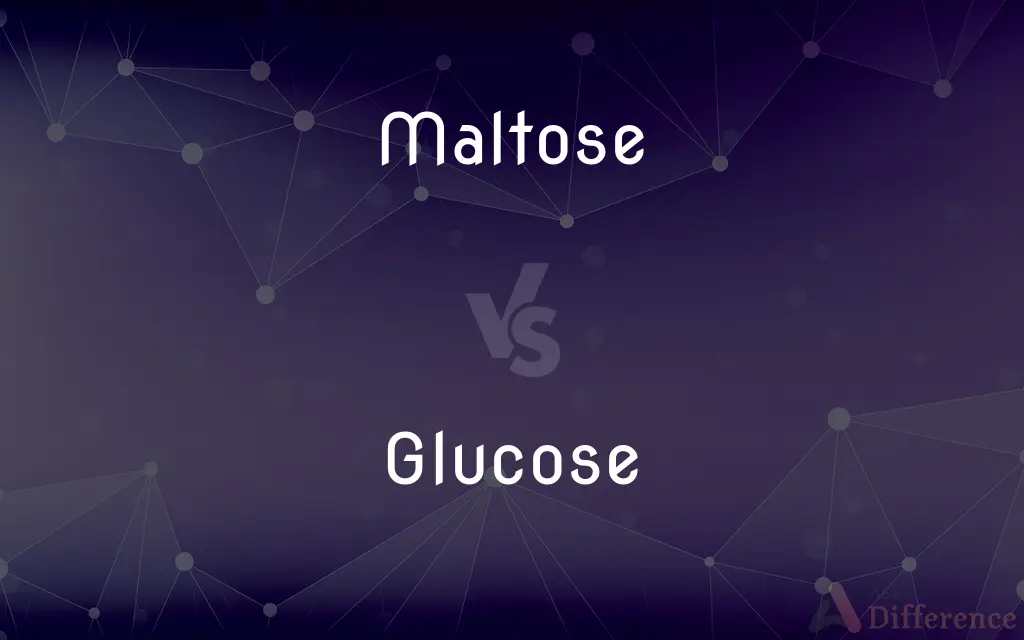Maltose vs. Glucose — What's the Difference?
By Urooj Arif & Fiza Rafique — Updated on April 8, 2024
Maltose is a disaccharide composed of two glucose molecules linked together, whereas glucose is a monosaccharide that serves as a fundamental energy source for living organisms.

Difference Between Maltose and Glucose
Table of Contents
ADVERTISEMENT
Key Differences
Maltose, also known as malt sugar, is a type of sugar that is formed when two glucose units join together. This process typically occurs during the digestion of starch in the human body or in the malting of grains. Whereas glucose is a simple sugar that is used directly by cells to produce energy through respiration. It is one of the most important carbohydrates and is found in the blood of animals and the sap of plants.
When it comes to nutritional sources, maltose is commonly found in foods that have undergone some form of fermentation or breakdown of starches, such as malted drinks and cereals. On the other hand, glucose is more widely available in nature, being present in fruits, honey, and as part of many other disaccharides and polysaccharides.
In terms of digestion and absorption, maltose must be broken down into its two glucose components by the enzyme maltase before it can be absorbed by the body. Glucose, however, does not require this step and can be directly absorbed into the bloodstream, where it is transported to cells to be used as energy.
Maltose is less sweet than glucose, reflecting their differences in taste and function. While glucose is often associated with the immediate provision of energy and sugar levels, maltose’s sweetness and energy provision are part of a slower, more complex digestion process.
The role of maltose and glucose in food industry and biology also differs. Maltose is prized for its flavor and is used in the production of beer and other fermented products. Glucose, being a primary source of energy for cells, is crucial in medical treatments for energy supplementation and in the food industry as a sweetener and a preservative.
ADVERTISEMENT
Comparison Chart
Type
Disaccharide (two glucose molecules)
Monosaccharide (single sugar molecule)
Sources
Malted grains, fermentation products
Fruits, honey, body fluids, starch breakdown
Digestion
Needs to be broken down into glucose by maltase
Directly absorbed and used by cells
Sweetness
Less sweet than glucose
Sweeter, primary sweet taste among sugars
Role in Biology
Intermediate in starch digestion, less direct energy source
Primary energy source, involved in metabolic processes
Industrial Use
Used in brewing, malt products
Used as a sweetener, in medical treatments, food preservation
Compare with Definitions
Maltose
Requires enzymatic breakdown to be used by the body.
Maltase breaks down maltose into glucose for absorption.
Glucose
A simple sugar that is an essential energy source.
Glucose levels in the blood are regulated by insulin.
Maltose
Found in malted foods and beverages.
The maltose in beer contributes to its distinctive taste.
Glucose
Found naturally in fruits and honey.
Grapes are a rich source of natural glucose.
Maltose
A sugar made from two glucose units.
Maltose is produced during the malting process of barley.
Glucose
Sweet and used widely as a sweetener.
Glucose syrup is used in candies and desserts.
Maltose
Less sweet compared to simple sugars.
Maltose has a milder sweetness than glucose.
Glucose
Important for metabolic processes.
Glucose metabolism is crucial for brain function.
Maltose
Used in the food industry for flavor.
Maltose is added to some breads for a subtle sweetness.
Glucose
Directly used by cells for energy.
Muscle cells quickly use glucose during intense exercise.
Maltose
Maltose ( or ), also known as maltobiose or malt sugar, is a disaccharide formed from two units of glucose joined with an α(1→4) bond. In the isomer isomaltose, the two glucose molecules are joined with an α(1→6) bond.
Glucose
Glucose is a simple sugar with the molecular formula C6H12O6. Glucose is the most abundant monosaccharide, a subcategory of carbohydrates.
Maltose
A sugar produced by the breakdown of starch, e.g. by enzymes found in malt and saliva. It is a disaccharide consisting of two linked glucose units.
Glucose
A simple sugar which is an important energy source in living organisms and is a component of many carbohydrates.
Maltose
A white disaccharide, C12H22O11, formed during the digestion of starch. Also called malt sugar.
Glucose
A colorless to yellowish syrupy mixture of dextrose, maltose, and dextrins containing about 20 percent water, used in confectionery, alcoholic fermentation, tanning, and treating tobacco. Also called starch syrup.
Maltose
(carbohydrate) A disaccharide, C12H22O11 formed from the digestion of starch by amylase; is converted to glucose by maltase; it is an isomer of trehalose
Glucose
(carbohydrate) A simple monosaccharide (sugar) with a molecular formula of C6H12O6; it is a principle source of energy for cellular metabolism.
Maltose
A crystalline disaccharide (C12H22O11) formed from starch by the action of diastase of malt, and the amylolytic ferment of saliva and pancreatic juice; called also maltobiose and malt sugar. Chemically it is 4-O-
Glucose
A variety of sugar occurring in nature very abundantly, as in ripe grapes, and in honey, and produced in great quantities from starch, etc., by the action of heat and acids. It is only about half as sweet as cane sugar. Called also dextrose, grape sugar, diabetic sugar, and starch sugar. See Dextrose.
Maltose
A white crystalline sugar formed during the digestion of starches
Glucose
Any one of a large class of sugars, isometric with glucose proper, and including levulose, galactose, etc.
Glucose
The trade name of a sirup, obtained as an uncrystallizable reside in the manufacture of glucose proper, and containing, in addition to some dextrose or glucose, also maltose, dextrin, etc. It is used as a cheap adulterant of sirups, beers, etc.
Glucose
A monosaccharide sugar that has several forms; an important source of physiological energy
Common Curiosities
Why is glucose more important for immediate energy than maltose?
Glucose is directly utilized by cells for energy, making it crucial for immediate energy needs, while maltose requires enzymatic breakdown first.
How do maltose and glucose differ in terms of digestion?
Maltose must be broken down into glucose molecules by the enzyme maltase, whereas glucose can be directly absorbed and utilized by the body.
Can the body use maltose directly for energy?
No, maltose must first be broken down into glucose molecules by enzymes before the body can use it for energy.
What is maltose?
Maltose is a disaccharide sugar composed of two glucose molecules, commonly found in malted grains and fermentation products.
What is glucose?
Glucose is a monosaccharide, or simple sugar, that serves as a primary energy source for cells in living organisms.
Where can you find maltose and glucose in the diet?
Maltose is found in malted foods and beverages, while glucose is widely present in fruits, honey, and many sweet foods.
What role does maltose play in the food industry?
Maltose is used for its flavor in brewing, baking, and in the production of malt-based foods.
How are maltose and glucose different in structure?
Maltose is a disaccharide made of two glucose units, while glucose is a single sugar molecule.
Are maltose and glucose equally sweet?
No, glucose is sweeter than maltose.
How does the body use glucose for energy?
The body breaks down glucose during cellular respiration to produce ATP, the energy currency of cells.
Is maltose bad for you?
Maltose, like all sugars, should be consumed in moderation as part of a balanced diet. Excessive intake can lead to health issues similar to those caused by too much sugar consumption.
What are some common sources of glucose?
Common sources include fruits, honey, and foods containing starch that has been broken down.
What happens to maltose during digestion?
During digestion, maltose is broken down by the enzyme maltase into two glucose molecules that the body can then absorb.
Share Your Discovery

Previous Comparison
Shut vs. Lock
Next Comparison
Wrap vs. WindAuthor Spotlight
Written by
Urooj ArifUrooj is a skilled content writer at Ask Difference, known for her exceptional ability to simplify complex topics into engaging and informative content. With a passion for research and a flair for clear, concise writing, she consistently delivers articles that resonate with our diverse audience.
Co-written by
Fiza RafiqueFiza Rafique is a skilled content writer at AskDifference.com, where she meticulously refines and enhances written pieces. Drawing from her vast editorial expertise, Fiza ensures clarity, accuracy, and precision in every article. Passionate about language, she continually seeks to elevate the quality of content for readers worldwide.
















































